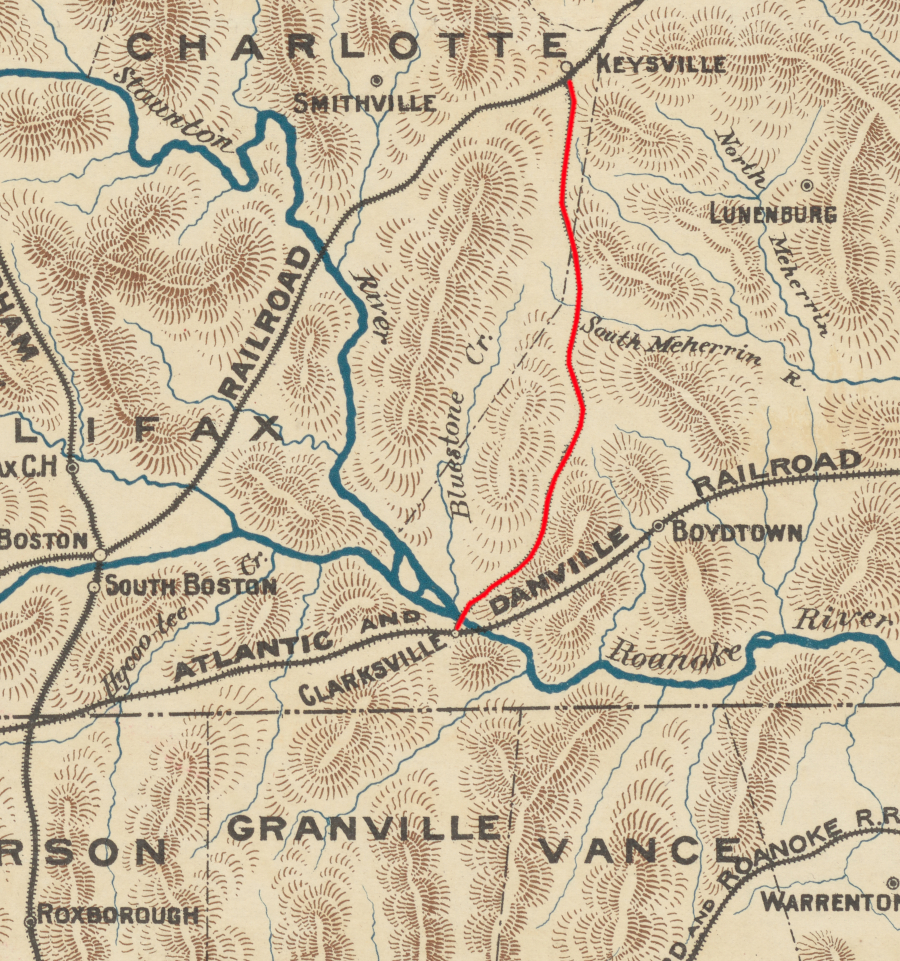
Richmond and Mecklenburg Railroad in 1890
Source: New York Public Library, Mineral territory tributary to Norfolk and Western Railroad (1890)

Richmond and Mecklenburg Railroad in 1890
Source: New York Public Library, Mineral territory tributary to Norfolk and Western Railroad (1890)
The Richmond and Mecklenburg Railroad connected Clarksville on the Roanoke River to the Richmond and Danville Railroad at Keysville.
Before the Civil War, the Roanoke Valley Railroad ran south from Clarksville to Manson, North Carolina. The railroad planned to extend its track north to Keysville in 1858, where it would connect with the Richmond and Danville Railroad. Instead of expanding north, the Roanoke Valley Railroad was dismantled during the Civil War. Confederate authorities used its track, locomotives, and rail cars to buld the Piedmont Railroad instead.
In 1868, the Richmond and Danville Railroad bought the rights of the Roanoke Valley Railroad to build the Clarksville-Keysville link. The Roanoke Valley Railroad had been chartered in 1850. It went bankrupt in 1870 and was reorganized in 1873.1
"Richmond and Mecklenburg Railroad," Annual Report, Virginia, Railroad Commissioner, 1898, p.399, https://books.google.com/books?id=mCUaAQAAIAAJ (last checked June 2, 2020)
To ensure that claims against that railroad by debtors would not be a complication, the Richmond and Danville Railroad got the General Assembly to issue a charter in 1875 for the Richmond and Mecklenburg Railroad. The charter granted that new rairoad the right to build from Clarksville to Keysville.
The Richmond and Danville Railroad acquired control of the Richmond and Mecklenburg Railroad in 1881. That made it possible to finance construction. The Richmond and Mecklenburg Railroad completed 31 miles of track from Keysville stretching south to Clarksville in 1884.2
Interstate Commerce Commission Reports: Decisions of the Interstate Commerce Commission of the United States. Valuation reports, Volume 37, U.S. Government Printing Office, 1932, p.76, https://books.google.com/books?id=Kp8FAAAAIAAJ (last checked July 14, 2020)
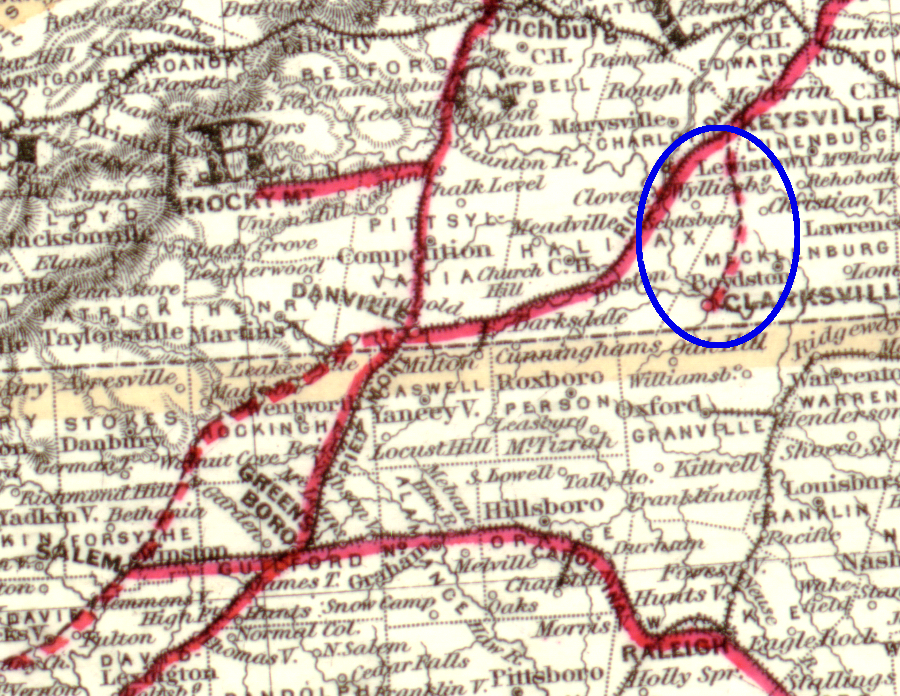
the Richmond and Danville Railroad had the rights to build between Keysville and Clarksville in 1881
Source: Library of Congress, Map of the Richmond & Danville Railroad system (G.W. & C.B. Colton & Co, 1881)
Construction of the Richmond and Mecklenburg Railroad created the town's first rail link to the north, and the first railroad link in over two decades. There was no railroad in Clarksville between the Civil War and 1884.
Clarksville re-established a railroad link to the south four years later. The track was not rebuilt to Manson along the old route of the Roanoke Valley Railroad. Instead, in 1888 the Oxford and Clarksville Railroad built from Clarksville south to Oxford, North Carolina. The seven-mile section in Virginia was chartered in 1887 as the Clarksville and North Carolina Railroad.
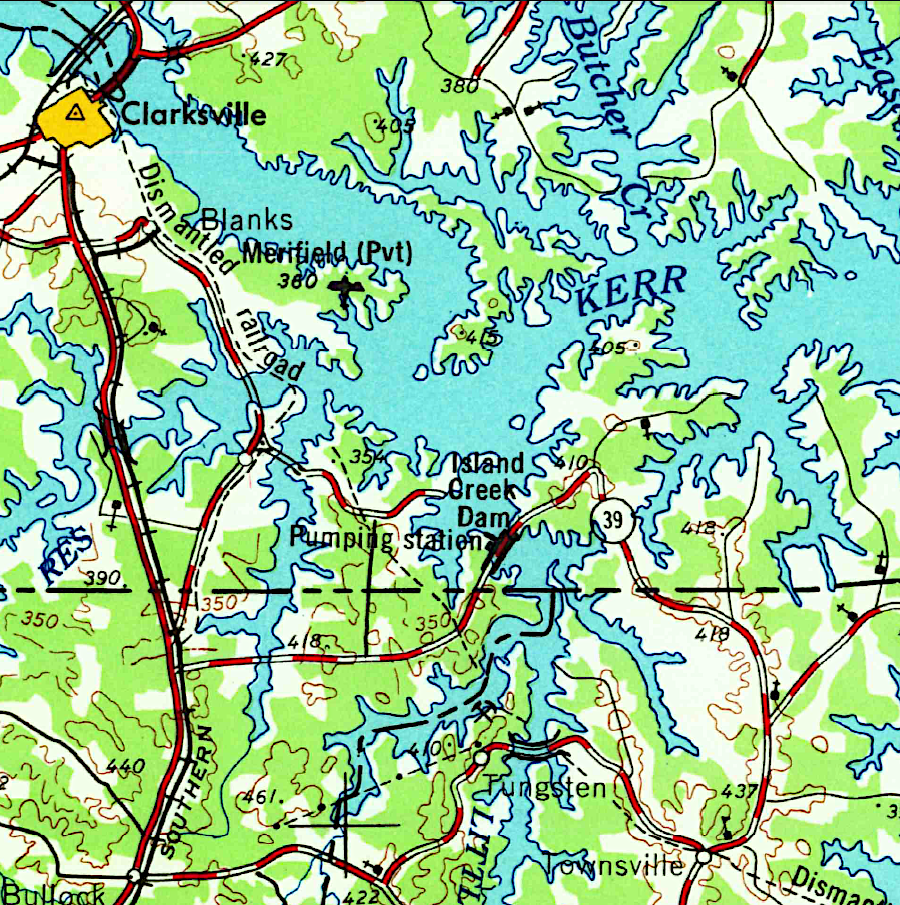
the route from Clarksville to Manson ("dismantled railroad") was not used in 1888; the railroad was built to Oxford instead
Source: US Geological Survey (USGS), Greensboro NC 1:250,000 topographic quadrangle (1966)
With completion of track to Oxford, there was a rail connection between Keysville (on the Richmond and Danville Railroad) and Oxford (on the North Carolina Railroad).
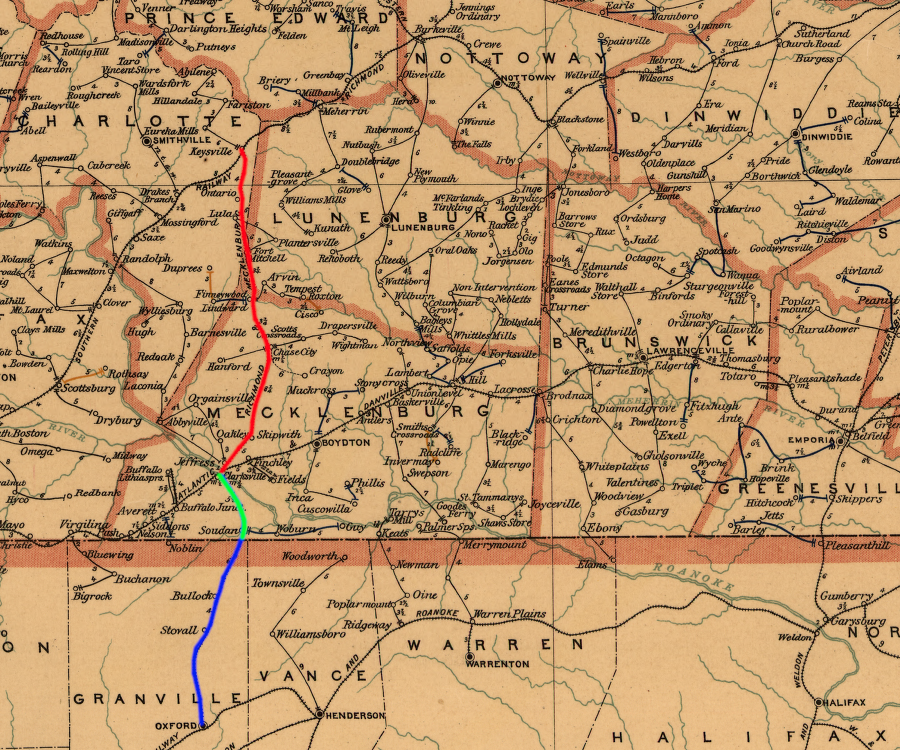
Clarksville was connected to the north by the Richmond and Mecklenburg Railroad (red), and to the south by the Clarksville and North Carolina Railroad (green)/Oxford and Clarksville Railroad (blue)
Source: Library of Congress, Post route map of the state of Virginia and West Virginia (1896)
The north-south line essentially paralleled the old Piedmont Railroad on the west and the old Petersburg Railroad on the east.
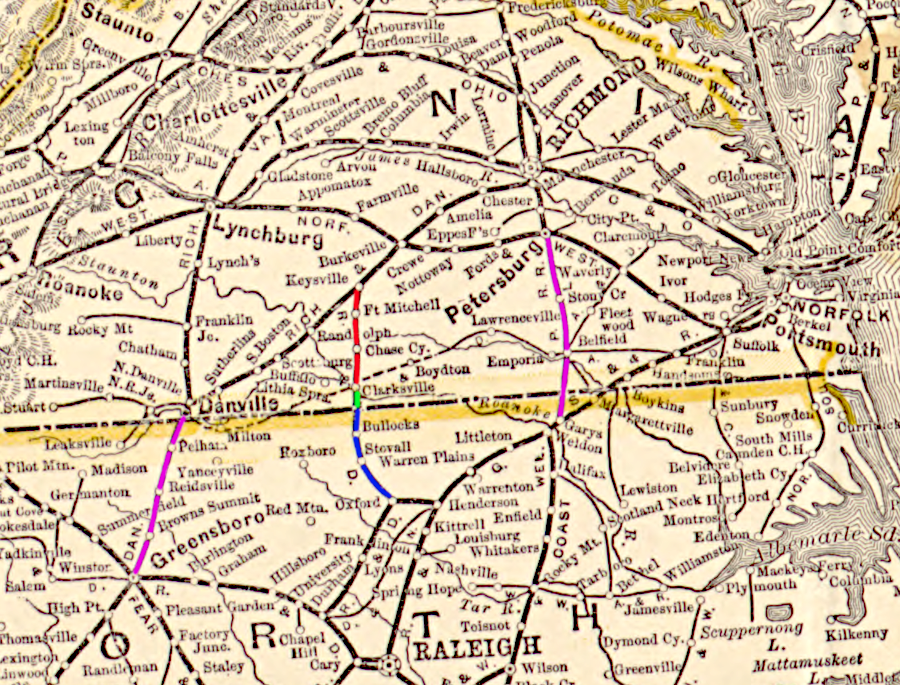
the Richmond and Mecklenburg Railroad (red), Clarksville and North Carolina Railroad (green), and Oxford and Clarksville Railroad (blue) created an alternative to other railroads linking North Carolina to Richmond/Petersburg (purple)
Source: Library of Congress, Map of the Nashville, Chattanooga and St. Louis Ry.; and connections. (by W. L. Danley, 1889)
In 1888, the Richmond and Danville Railroad acquired by lease both the Richmond and Mecklenburg Railroad and the Oxford and Clarksville Railroad. Those leases gave the Richmond and Danville Railroad two paths to transport the cotton flowing northeast through the Piedmont of North Carolina to Richmond.
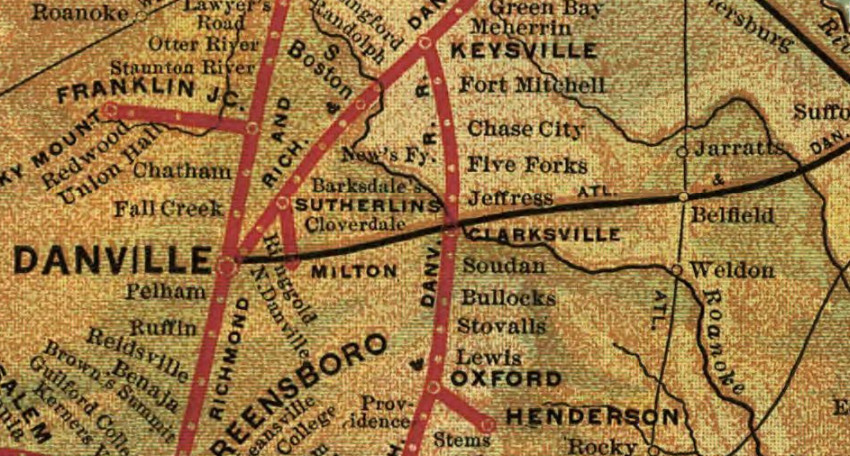
the Richmond and Danville Railroad controlled the Richmond and Mecklenburg Railroad and the Oxford and Clarksville Railroad in 1893
Source: Library of Congress, Birds-eye-view of the Richmond & Danville Railroad and the Florida Central & Peninsular Systems and their connections (1893)
When the Richmond Terminal Company and the Richmond and Danville Railroad were reorganized in 1894, the Richmond and Mecklenburg Railroad became independent again. The Southern Railway executed its own 50-year lease with the Richmond and Mecklenburg Railroad in 1898. The Southern Railway trains go fo from Richmond southwest to Keysville, then via the Richmond and Mecklenburg track to Clarksville and the Oxford and Clarksville Railroad to reach the main east-west route going through North Carolina.1
Fairfax Harrison, A history of the legal development of the railroad system of Southern Railway Company, Washington DC, 1901, p.98, pp.507-529, https://books.google.com/books?id=0IkjAQAAMAAJ; "North Carolina Railroads - Roanoke Valley Railroad," Carolana, http://www.carolana.com/NC/Transportation/railroads/nc_rrs_roanoke_valley.html; "North Carolina Railroads - Oxford & Clarksville Railroad," Carolana, http://www.carolana.com/NC/Transportation/railroads/nc_rrs_oxford_clarksville.html; "North Carolina Railroads - Oxford & Henderson Railroad," Carolana, http://www.carolana.com/NC/Transportation/railroads/nc_rrs_oxford_henderson.html; Alan Coleman, "The P&W Supplement to Railroads of North Carolina," http://www.pwrr.org/ncrrs.html; William E. Griffin Jr., The Atlantic and Danville Railway Company, TLC Publishing, 2006, pp.4-5; "From Richmond to Keysville on the Southern in Virginia," Ties, Souhern Railway, April 1949, http://www.odcnrhs.org/history_files/richmond_to_keysville_on_the_southern.pdf (last checked December 2, 2018)
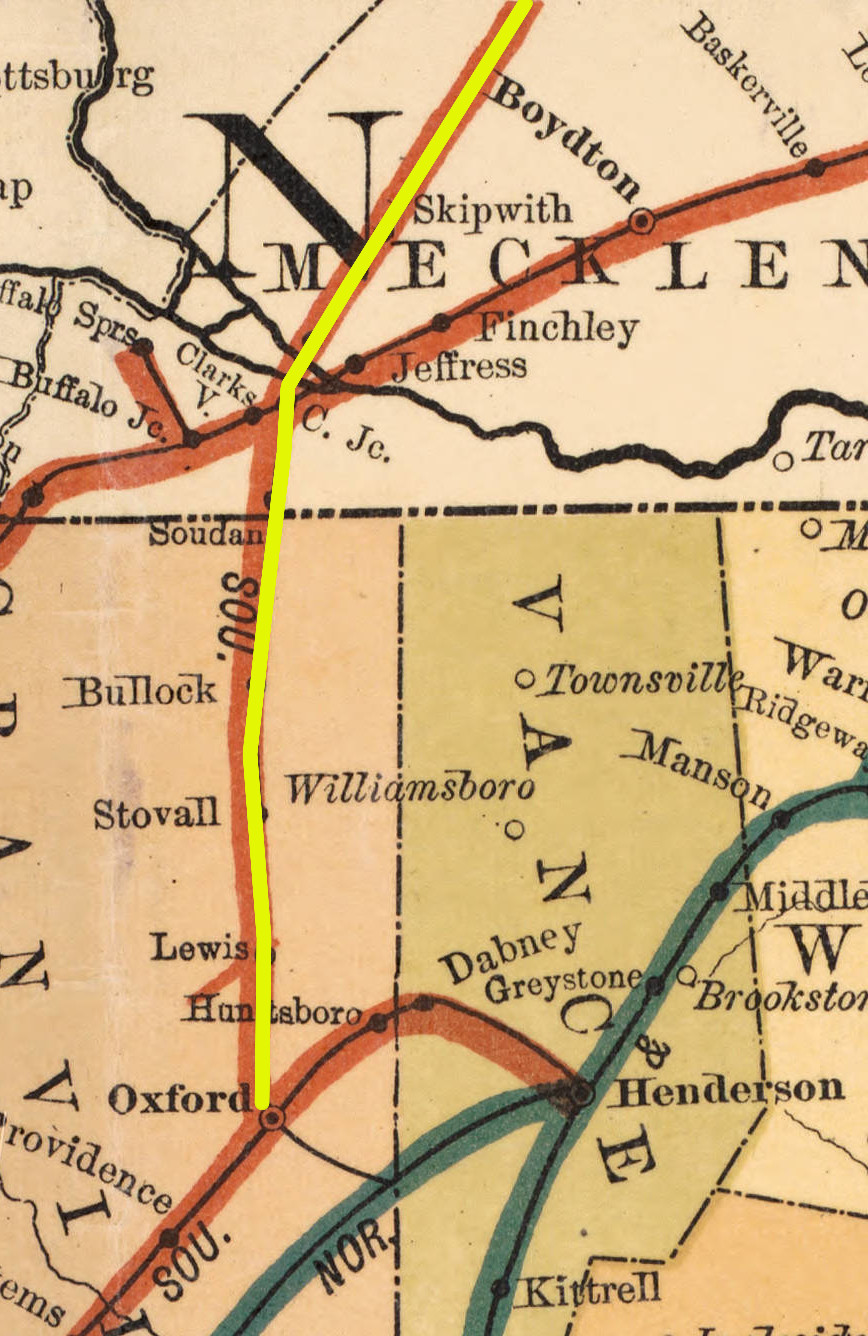
starting in 1894, the Southern Railway controlled the track between Keysville, Virginia and Oxford, North Carolina
Source: University of North Carolina Libraries, Railroad map of North Carolina 1900 (by Henry C. Brown, 1900)
In 1889, when the Atlantic and Danville Railroad built west from Emporia to Danville, the Richmond and Danville Railroad authorized the Atlantic and Danville Railroad to use almost two miles of Richmond and Mecklenburg Railroad track at Clarksville . That lease arrangement left a permanent two-mile gap in the Atlantic and Danville Railroad.
After the merger between the Southern and the Norfolk and Western in 1982 to create the Norfolk Southern Railroad, the track between Oxford and Keysville became surplus.
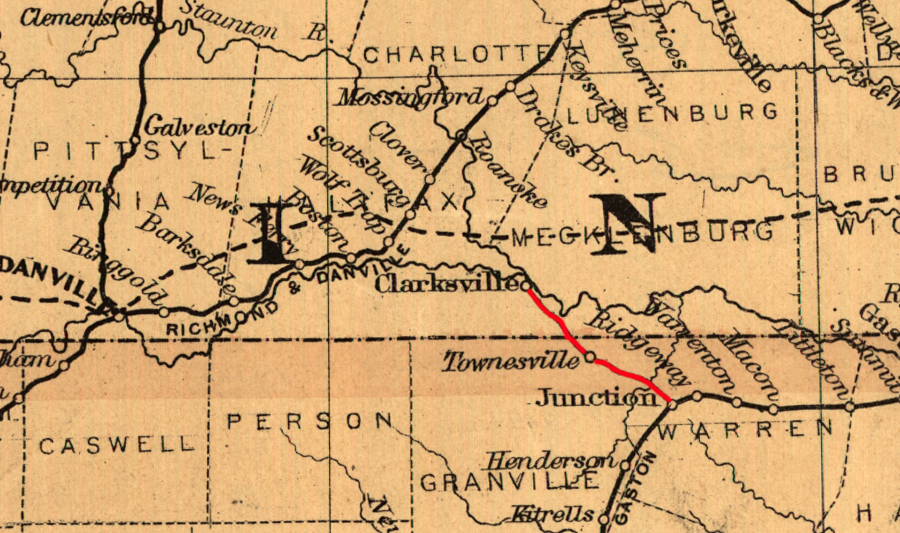
in 1943, the Southern Railway operated trains on track south of Clarksville to Oxford, North Carolina
Source: US Geological Survey (USGS), Clarksville 1:24,000 topographic quadrangle (1943)
The Norfolk Southern leased the track to RailTex in 1988, creating a Class III shortline railroad known as the Virginia Southern. The Virginia Southern was the first spinoff of low-traffic branch lines in the Norfolk Southern's efforts to create the Thoroughbred Shortline Program.
The RailTex conglomerate of shortline railroads was acquired by RailAmerica in 2000. The Buckingham Branch acquired the lease from Norfolk Southern in 2009.
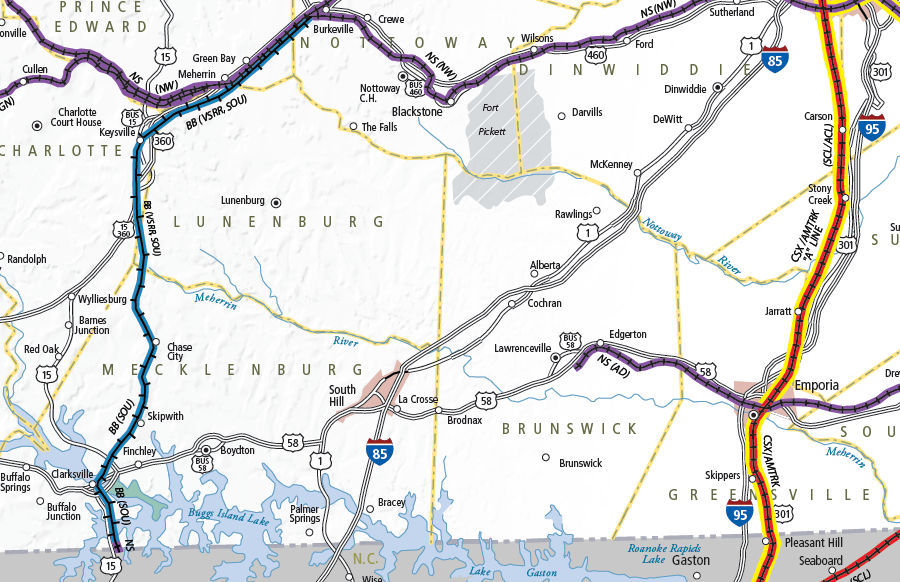
the Buckingham Branch now operates the Virginia Southern shortline between Burkeville and Clarksville
Source: Virginia Department of Rail and Public Transportation, Virginia State Railroad Map (2012)
The Virginia Southern is a short line railroad linking Burkeville and Clarksville. The track is owned by the Norfolk Southern, but is leased to other railroads willing to operate it as a "feeder" to increase traffic on the Norfolk Southern's mainline at Burkeville. The Buckingham Branch currently operates the Virginia Southern Railroad on 59 miles of track south of Burkeville.2
"Virginia Southern Division," Buckingham Branch, http://buckinghambranch.com/virginia-southern-division/; Edward A. Lewis, "American Shortline Railway Guide," Kalmbach Publishing, 1996, p.323, https://books.google.com/books?id=3i6K_Nf9e2EC; "Virginia Southern Railroad," Central Virginia Railfan Page, http://www.trainweb.org/varail/vs.html; "North Carolina Railroads - Virginia Southern Railroad," Carolana, http://www.carolana.com/NC/Transportation/railroads/nc_rrs_va_southern.html (last checked June 21, 2018)
The 19 miles of the shortline that RailTex formerly used to connect with Oxford, North Carolina, has not been active since the 1980's. Norfolk Southern has not abandoned the line, so there is no opportunity yet to create a 15-mile hiking trail on the right-of-way.3 "The Oxford and Clarksville Railroad," AbandonedRails.com, http://www.abandonedrails.com/Oxford_and_Clarksville_Railroad; "Docket No. AB-290 (Sub-No. 316X) Norfolk Southern Railway Company - Discontinuance of Service Exemption - Mecklenburg County, VA and Granville County, NC (Clarksville VA to at Oxford & Henderson Railroad Junction near Oxford, NC)," May 11, 2009, https://www.stb.gov/filings/all_2000s.nsf/a7112cc28c158bd0852572b00076dc88/85257ca7006c955b852575ba00741011/$FILE/225125.PDF (last checked December 2, 2018)
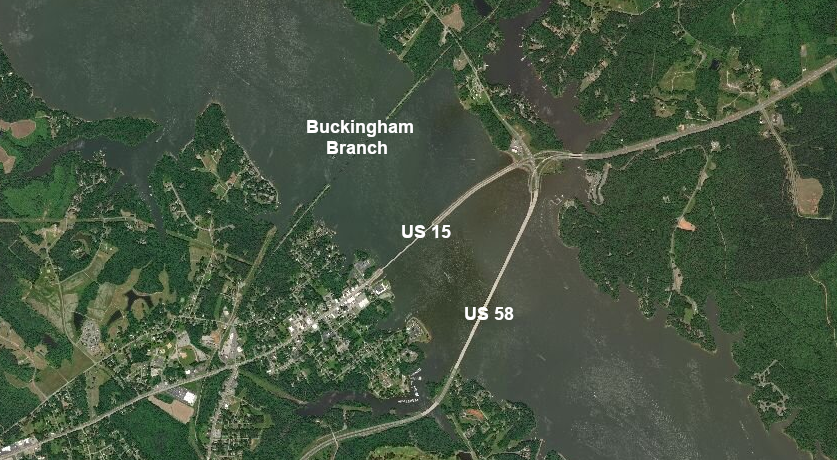
the railroad bridge crosses Buggs Island Lake/Kerr Reservoir upstream of two highway bridges at Clarksville
Source: ESRI, ArcGIS Online